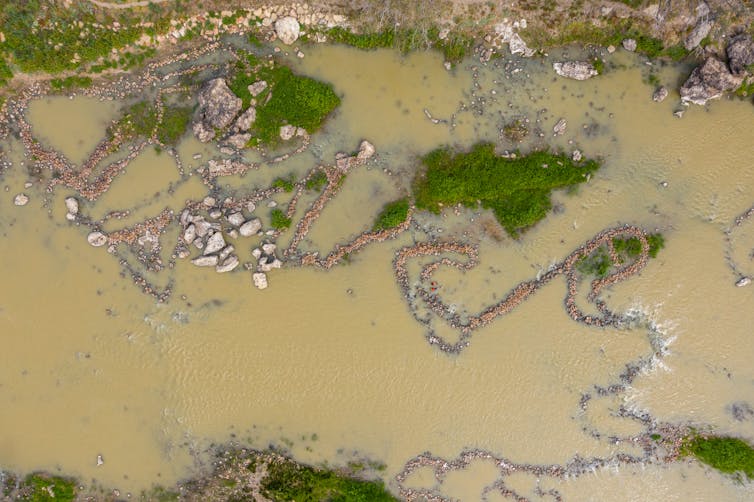Source: The Conversation (Au and NZ) – By Jessica Russ-Smith, Associate Professor, Social Work and Assistant Deputy Head of School, School of Allied Health, Australian Catholic University
From climate change to geopolitical instability to health emergencies, we are entering a period of momentous change. The technology industry likes to tell us that the antidote is artificial intelligence (AI).
But as things currently stand, AI is actually accelerating climate change, harming Country and perpetuating systemic racism.
It doesn’t have to be this way. In fact, AI can address many of the problems facing the world today.
One way to ensure this is by centring Wiradyuri (an Indigenous nation in central New South Wales) and other sovereign First Nations ways of knowing and being with the world and technology.
A long history
First Nations cultures from around the world have a long history of creating and using technology.
For example, Aboriginal and Torres Strait Islander fish traps and fishing practices support sustainable fishing. They allow fish populations to thrive and eliminate waste by using the entire fish.
Inuit people from modern day North America also carved bones into snow goggles and waterproofed their canoes with raw bitumen.
These examples reflect how First Nations cultures have long developed technology to help care for and enhance all life – including Country. This is a very different approach to technology to the one we find in settler colonial cultures.

John Carnemolla/Shutterstock
A logic of destruction
Settler colonialism is where people from one country settle permanently on land where others already reside. The intention of the colonisers is to destroy what isn’t wanted (including Country and First Nations cultures), take what is desired and replace the existing social structure.
Modern nations such as the United States and Australia are examples of settler colonies.
There are numerous examples in history of people using technology to facilitate settler colonial violence. These include the infamous Tuskegee syphilis experiment which began in 1932 and continued to 1972, and the forced sterilisation of Indigenous peoples in Canada throughout the 20th century.
With the US leading AI research and development, the dominant forms of contemporary technology are perpetuating the settler-colonial logic of destroying and replacing culture, Country and communities. This AI-driven settler-colonialism is occurring at a speed and reach far greater than in the past.
Some forms of AI are programmed to steal data and erase certain perspectives, voices and experiences. People are also using the technology to specifically harm Indigenous peoples.
For example, during last year’s referendum on whether or not to create an Indigenous “Voice to Parliament” in Australia, AI was used to spread misinformation and appropriate Indigenous art in support of the “No” vote.
Time to transform
For lead author Jess, a sovereign Wiradyuri Wambuul woman, her understanding of AI draws from the Wiradyuri cosmology which teaches us that everything is related. This simple yet profound concept is encapsulated by the Wiradyuri concept “Wayanha”.
Loosely translated to English, Wayanha means transformation. It teaches that everything always exists, and has always existed. In this way a person, thing or place never simply begins or ends. Instead, it transforms.
This is as true of AI as it is of humans. Just as humans have the DNA which are the biological elements of those that came before us, so too does AI have the technological and cultural elements of what came before it.
Looking at AI this way highlights that this technology – and its impact on our world – isn’t a recent phenomenon, as some suggest. While dominant forms of AI may be different from technologies of the past, its harm on the world around us echoes that of all prior technology-aided settler-colonial violence.
Growing resistance
But this technological transformation is not a foregone conclusion. There is a growing movement of people resisting the pervasive settler-colonial AI transformations.
For example, there is the Lakota Language Learning Model project that is using a locally developed AI to preserve the native Lakota language in North America. There is also the Indigenous AI Abundant Intelligences research program that is exploring how to develop technology grounded in First Nations ways of knowing that “recognise the abundant multiplicity of ways of being intelligent in the world”.
You can trace the lineage of these examples back thousands of years to those ancient fish traps and other forms of sovereign First Nations technologies.
They show that technology doesn’t have to be harmful to people and Country in the way the dominant AI transformation currently is. Instead, by being First Nations-led, local, contextualised, purpose-built and sustainable, AI can help care for and preserve people and Country.
![]()
Jessica Russ-Smith is affiliated with the Australian Association of Social Workers where she is a non-executive Board Director.
Michelle Lazarus does not work for, consult, own shares in or receive funding from any company or organisation that would benefit from this article, and has disclosed no relevant affiliations beyond their academic appointment.
– ref. AI for life: how sovereign Wiradyuri ways of knowing can transform technology for good – https://theconversation.com/ai-for-life-how-sovereign-wiradyuri-ways-of-knowing-can-transform-technology-for-good-243270








